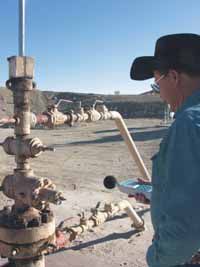| Carbon planning director Dave Levanger stands by a gas well in the southwest part of the county using a decibel meter to check the sound levels that the machine is putting out. Concerns regarding the noise created by the machines are growing in county government and with residents as the wells are drilled closer and closer to homes in the area. |
On Tuesday, Carbon County planning director Dave Levanger stood in front of the “horsehead” going up and down as it pumped its valuable commodity into the pipeline that delivers it to customers.
In his hand, the county planning director held a meter that measures the decibels (dB) that the machine was emitting.
“I’m certainly no scientist or expert,” said Levanger. “But I hope, by doing this, we have more information on how these pumps are affecting the noise levels in the neighborhood.”
Levanger and deputy zoning administrator Gayla Williams were taking dB readings in various places near where another three wells were proposed by Phillips Petroleum at last week’s planning and zoning board meeting.
Several residents in the southwest part of the county claim that the pumps are causing a noise problem, especially at night during the summer months when they have their windows open.
Sound is measured by science in dB. The higher the reading, the higher the sound level.
The noise level is measured from the threshold of hearing, which would be a 0 dB reading.
The rustling of leaves without background sound would measure at 10.
The average whisper meters out at 20 dB. Standing next to a busy street with a lot of traffic would give an intensity of 65-70 dB.
Trains, another familiar local sound, come in at 65 to 90 dB.
The threshold of pain for the normal person is 130 dB and a number of modern devices such as jet engines at close range can produce the level sound in question.
Sound is much like the waves a rock produces when tossed in a large pool of water.
The waves emanate in all directions from the splash point and span out, getting weaker as they travel farther away from the impact point.
Sound, in the same manner, gets softer as it travels farther away from its source. When measuring sounds to determine the affects on people, it is a good idea to test the noises at the source and at various distances from the site.
On Tuesday, Levanger and Williams first traveled to the neighborhood near 500 West 2400 South and took readings on the sound levels in the area.
At approximately 2:30 p.m. , the ambient or background noise levels were much higher than the sounds would be during the night.
The noise from Utah Highway 10, jet airliners flying overhead and other sounds created a level that evened out at about 35 dB.
The sounds of wells pumping near the location were not detectable to the members of the party.
The next stop was a well not far from Highway 10 on the gas field road running west from the junction of Ridge Road.
Levanger took readings directly at the well head, a device that had a high pitched squeak when it reached the apex of its cycle. The dB reading at the well head motor was 70.
Levanger paced off 90 feet and took reading, which measured 42 dB. At approximately 220 feet, the level was 37.
The members of the party then drove east to a well that was the closest to the houses where the first reading was taken. About 300 yards from the well, there was heavy equipment working on a project that affected the readings.
The reading at the well motor was 68 dB. At the head, the reading was 59 dB. At 90 feet, it was 55 dB.
The well site also had a large berm around it which was highest in the direction of the closest homes. Below the berm, the sound level was 42 dB.
The final well tested by the members of the party was 594, located across the irrigation canal behind some hills at the end of 500 West.
A rudimentary measure of the distance between the well and the closest home was approximately 400 yards. The noise level tested at 66 dB at the motor and 56 at the well head.
A few years ago, the county decided to enact an ordinance on noise that involved the natural gas compressions station near Gordon Creek.
Compressor stations are considerably nosier than wells. The ordinance specified that the sound from a compressor stations should not exceed 55 dB at 1,200 feet.
With the wells moving closer to residential areas, county planning board members, particularly Lynna Topolovec, have voiced concerns regarding how the sound levels will impact people living in the nearby houses.
The sound a source emits can be affected by various factors, including the humidity in the air and the temperature.
In addition, how sounds affect an individual and how people perceive noise cannot be read by any type of meter. And readings cannot determine whether the noise is annoying to an individual.
“I think there are a lot of different factors in dealing with the sound problems that could arise from these wells, despite the readings we took today,” pointed out Levanger.
“We probably need to come out here at night and see if the sounds come through near the houses more clearly, and what those readings may be. This is a situation we need to continue to monitor,” concluded the county planning director.

